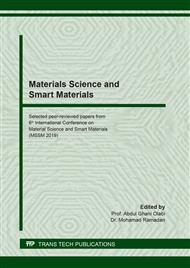[1]
Alami, A H et al. (2018). Assessment of Calotropis natural dye extracts on the efficiency of dye-sensitized solar cells. Agronomy Research, 16(4), p.1569–1579. [online]. Available from: https://doi.org/10.15159/AR.18.166 [Accessed April 1, 2019].
Google Scholar
[2]
Alami, Abdul Hai et al. (2018). Assessment of Photoelectrode Material Based on (TiO2)1-x / (Al65Cu24Fe11)x in Dye-Sensitized Solar Cell Applications. Materials Science Forum, 928, p.94–99.[online]. Available from:https://www.scientific.net/MSF.928.94 [Accessed April 1, 2019].
DOI: 10.4028/www.scientific.net/msf.928.94
Google Scholar
[3]
Carp, O., Huisman, C.L. and Reller, A. (2004). Photoinduced reactivity of titanium dioxide. Progress in Solid State Chemistry, 32(1–2), p.33–177. [online]. Available from: https://www.sciencedirect.com/science/article/pii/S0079678604000123?via%3Dihub [Accessed July 6, 2019].
DOI: 10.1016/j.progsolidstchem.2004.08.001
Google Scholar
[4]
Choi, J.-Y. et al. (2009). Photocatalytic Antibacterial Effect of TiO 2 Film of TiAg on Streptococcus mutans. The Angle Orthodontist, 79(3), p.528–532.
DOI: 10.2319/012108-169.1
Google Scholar
[5]
Elani, H.W. et al. (2018). Trends in Dental Implant Use in the U.S., 1999–2016, and Projections to 2026. Journal of Dental Research, 97(13), p.1424–1430.
DOI: 10.1177/0022034518792567
Google Scholar
[6]
Maness, P.C. et al. (1999). Bactericidal activity of photocatalytic TiO2reaction: Toward an understanding of its killing mechanism. Applied and Environmental Microbiology.
Google Scholar
[7]
Norowski, P.A. and Bumgardner, J.D. (2009). Biomaterial and antibiotic strategies for peri-implantitis: A review. Journal of Biomedical Materials Research Part B: Applied Biomaterials, 88B(2), p.530–543.
DOI: 10.1002/jbm.b.31152
Google Scholar
[8]
Ohsaka, T., Izumi, F. and Fujiki, Y. (1978). Raman spectrum of anatase, TiO2. Journal of Raman Spectroscopy, 7(6), p.321–324. [online]. Available from: http://doi.wiley.com/10.1002/jrs.1250070606 [Accessed June 26, 2019].
DOI: 10.1002/jrs.1250070606
Google Scholar
[9]
Pantaroto, H.N. et al. (2018). Antibacterial photocatalytic activity of different crystalline TiO2 phases in oral multispecies biofilm. Dental Materials.
DOI: 10.1016/j.dental.2018.03.011
Google Scholar
[10]
Salvi, G.E., Cosgarea, R. and Sculean, A. (2017). Prevalence and Mechanisms of Peri-implant Diseases. Journal of Dental Research, 96(1), p.31–37.
DOI: 10.1177/0022034516667484
Google Scholar
[11]
Suketa, N. et al. (2005). An Antibacterial Surface on Dental Implants, Based on the Photocatalytic Bactericidal Effect. Clinical Implant Dentistry and Related Research, 7(2), p.105–111.
DOI: 10.1111/j.1708-8208.2005.tb00053.x
Google Scholar
[12]
Tagliareni, J.M. and Clarkson, E. (2015). Basic Concepts and Techniques of Dental Implants. Dental Clinics of North America, 59, p.255–264.
DOI: 10.1016/j.cden.2014.10.005
Google Scholar
[13]
Wang, Y. et al. (2014). A novel self-cleaning, non-enzymatic glucose sensor working under a very low applied potential based on a Pt nanoparticle-decorated TiO2 nanotube array electrode. Electrochimica Acta, 115, p.269–276.
DOI: 10.1016/j.electacta.2013.09.173
Google Scholar
[14]
Zhang, D. et al. (2018). Efficiency and high-temperature response of dye-sensitized solar cells using natural dyes extracted from Calotropis. In 5th International Conference on Renewable Energy: Generation and Application, ICREGA (2018).
DOI: 10.1109/icrega.2018.8337593
Google Scholar


